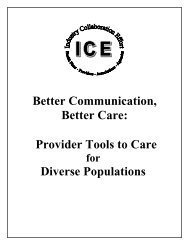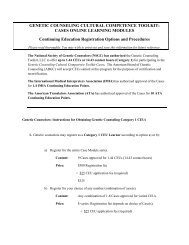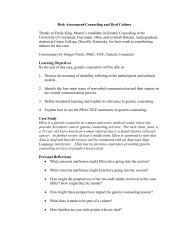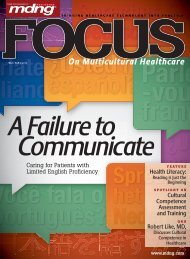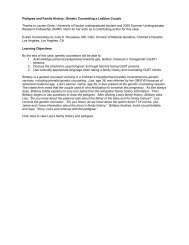Advanced Effective Communication, Cultural Competence, and ...
Advanced Effective Communication, Cultural Competence, and ...
Advanced Effective Communication, Cultural Competence, and ...
Create successful ePaper yourself
Turn your PDF publications into a flip-book with our unique Google optimized e-Paper software.
A Roadmap for Hospitals<br />
ChapterThree: Treatment<br />
Address the patient’s unique needs <strong>and</strong> preferences during<br />
the discussion <strong>and</strong> incorporate them into relevant written<br />
materials <strong>and</strong> forms. This supports the patient’s ability to<br />
underst<strong>and</strong> <strong>and</strong> act on health information.<br />
• Ask the patient how he or she prefers to receive<br />
information (for example, by reading, hearing, or<br />
viewing).<br />
• Speak in plain language <strong>and</strong> avoid using technical<br />
terminology or medical jargon. Include examples <strong>and</strong><br />
stories whenever possible.<br />
• Use visual models, diagrams, or pictures to illustrate a<br />
procedure or condition.<br />
• Help the patient gather basic health information by using<br />
methods such as AskMe3, a strategy for asking <strong>and</strong><br />
answering three questions about the patient’s care [2].<br />
• Use the “teach back” method to assess underst<strong>and</strong>ing.<br />
This involves asking the patient to explain in his or her<br />
own words the information that the staff shared or<br />
asking the patient to demonstrate a skill that was taught.<br />
• Refrain from simply asking the patient “Do you<br />
underst<strong>and</strong>?” Regardless of their ability to underst<strong>and</strong><br />
the information, many people who do not underst<strong>and</strong><br />
may still answer, “Yes.”<br />
• Notify the patient of ongoing opportunities to ask<br />
questions. Encourage the patient to write notes or<br />
check off key information on patient materials during<br />
discussions.<br />
• Use informed consent materials that meet health literacy<br />
needs. Materials should be written at a 5th grade or<br />
lower reading level. Consider revising written materials<br />
to address the health literacy needs of all patients. Use<br />
readability tests, divide complex information into bullet<br />
points, <strong>and</strong> modify document font, layout, <strong>and</strong> design<br />
improve readability.*<br />
• Use translated informed consent materials in the<br />
patient’s language whenever possible. Provide an<br />
interpreter for the patient’s preferred language during<br />
informed consent discussions, even if the hospital<br />
provides translated materials, to facilitate patient<br />
communication. †<br />
• If translated documents are not available, interpreters<br />
should not attempt a sight translation; instead the<br />
clinician should obtain the patient’s consent verbally.<br />
Helpful Tip: Translate<br />
Documents for Informed Consent<br />
Hospitals cannot expect interpreters to be able to sight<br />
translate (that is, express verbally what is in the written text) a<br />
complex legal document into the patient’s preferred language.<br />
Sight translation requires a different skill set than verbal<br />
interpretation. To avoid errors <strong>and</strong> poor translations, hospitals<br />
should obtain written translations <strong>and</strong> not rely on interpreters<br />
to sight translate informed consent documents.<br />
The National Council on Interpreting in Health Care<br />
recommends professional translation for legal documents<br />
such as consent forms for the following reasons:<br />
• Formality of the language <strong>and</strong> complexity of a text<br />
with many legal terms<br />
• Many health care interpreters lack familiarity with<br />
legal terminology <strong>and</strong> there is a resulting risk for<br />
inaccuracies if required to translate on site<br />
• The inability of many patients to underst<strong>and</strong> <strong>and</strong><br />
retain information provided during a long <strong>and</strong><br />
complex sight translation<br />
Reference: National Council on Interpreting in Health<br />
Care: Sight Translation <strong>and</strong> Written Translation: Guidelines<br />
for HealthCare Interpreters. Working Paper Series.<br />
Washington, DC: National Council on Interpreting in<br />
Healthcare, April 2009. Available on http://data<br />
.memberlinks.com/site/ncihc/Translation_Guidelines_for_<br />
Interpreters_Final042709.pdf. (Accessed March 1, 2010.)<br />
• Note the receipt of informed consent <strong>and</strong> any<br />
communication assistance used to obtain it in the<br />
medical record.<br />
❑ Provide patient education that meets<br />
patient needs.<br />
Patient education discussions <strong>and</strong> materials should be<br />
modified to the patient’s ability to underst<strong>and</strong> <strong>and</strong> act on<br />
health information.<br />
• Ask the patient how he or she prefers to receive<br />
information (for example, by reading, hearing, or<br />
viewing).<br />
* See Chapter 6: Organization Readiness: Provision of Care, Treatment, <strong>and</strong> Services (page 42) for additional information on integrating health<br />
literacy strategies into patient discussions <strong>and</strong> materials.<br />
† See Appendix D: Laws <strong>and</strong> Regulations (page 67) for additional information on what documents require translation.<br />
20


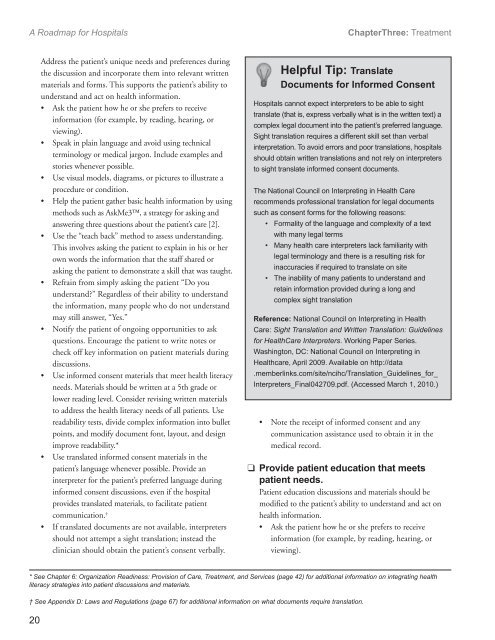
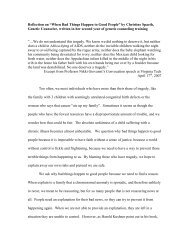
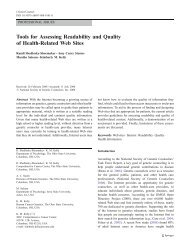

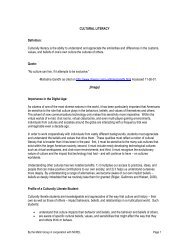
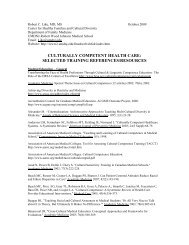

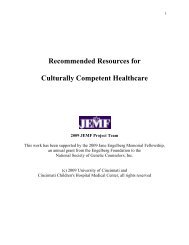

![Breaking Bad News PPT[1] - Genetic Counseling Cultural ...](https://img.yumpu.com/35003134/1/190x146/breaking-bad-news-ppt1-genetic-counseling-cultural-.jpg?quality=85)
